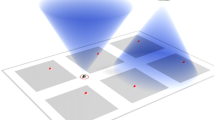Abstract
Genetic programming provides a useful tool for emergent computation and artificial life research. However, conventional genetic programming is not efficient enough to solve realistic multiagent tasks consisting of several emergent behaviors that need to be coordinated in the proper sequence. In this paper, we describe a novel method, called fitness switching, for evolving composite cooperative behaviors in multiple robotic agents using genetic programming. The method maintains a pool of basis fitness functions which are switched from simpler ones to more complex ones. The performance is demonstrated and evaluated in the context of a table transport problem. Experimental results show that the fitness switching method is an effective mechanism for evolving collective behaviors which can not be solved by simple genetic programming.
Similar content being viewed by others
References
Koza JR (1992) Genetic programming on the programming of computers by means of natural selection. MIT Press, Cambridge
Bennett III FH (1996) Automatic creation of an efficient multiagent architecture using genetic programming with architecture-altering operations. In: Koza JR, Goldberg DE, Fogel DB, Rioli RL (eds) Proceedings of the First Genetic Programming Conference (GP-96), California, USA, July 28–31, 1996, pp 30–38
Haynes T, Sen S, Schoenefeld D et al. (1995) Evolving a team. In: Siegel EV, Koza JR (eds) Proceedings of AAAI-95 Fall Symposium on Genetic Programming, Cambridge, MA, USA, Nov 10–12, 1995, pp 23–30
Luke S, Spector L (1996) Evolving teamwork and coordination with genetic programming. In: Koza JR, Goldberg DE, Fogel DB, Rioli BL (eds) Proceedings of the First Genetic Programming Conference (GP-96), California, USA, July 28–31, 1996, pp 150–156
Iba H (1997) Multi-agent learning for a robot navigation task by genetic programming. In: Koza JR, Deb K, Dorigo M, et al. (eds) Proceedings of the Second Genetic Programming Conference (GP-97), California, USA, July 13–16, 1997 pp 195–200
Zhang BT, Hong YJ (1998) Evolution of herding behavior of multiple autonomous mobile robots. In: Sugisaka M (ed) Proceedings of the Third International Symposium on Artificial Life and Robotics, Beppu, Oita, Japan, Jan 19–21, 1998, pp 166–169
Zhang BT, Cho DY (1998) Fitness switching: evolving complex group behaviors using genentic programming. In: Koza JR, Banzhaf W, Chellapilla K., et al. (eds) Proceedings of the Third Genetic Programming Conference (GP-98), Madison, WI, USA, July 22–25, 1998, pp 431–438
Zhang BT, Ohm P, Mühlenbein H (1997) Evolutionary induction of sparse neural trees. Evol Comput 5:213–236
Author information
Authors and Affiliations
Corresponding author
About this article
Cite this article
Zhang, BT., Cho, DY. Evolving complex group behaviors using genetic programming with fitness switching. Artif Life Robotics 4, 103–108 (2000). https://doi.org/10.1007/BF02480864
Received:
Accepted:
Issue Date:
DOI: https://doi.org/10.1007/BF02480864




